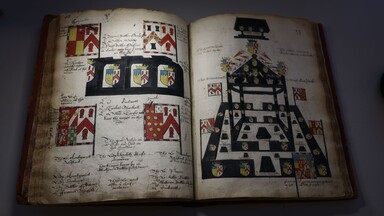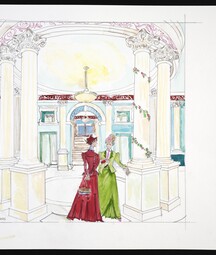This is of little surprise as the NLI is the home of the Office of the Chief Herald of Ireland which inherited the records of its institutional predecessor: the Office of the Ulster King of Arms which was established in 1552. The Library continues to add to this collection and in 2022 acquired a grant of arms issued in 1554 by the then Ulster King of Arms, Bartholomew Butler, which contains a superb illustration of Butler himself (MS L 559).
1) The Coat of Arms of Lady Elizabeth Botheler

The Coat of Arms of Lady Elizabeth Botheler
A chronological outlier to this collection can be found in the library’s oldest heraldic manuscript, GO MS 7. This composite volume, based on its contents, was created in England sometime in the fifteenth century. That it cannot date from an earlier period is confirmed by two pieces of information. Firstly, the blazon (or heraldic description) for the coat of arms of Anne (of Bohemia), who is described as queen consort of Richard II. Anne was Queen of England in the late fourteenth century and died in 1394. Secondly, a coat of arms elsewhere in the manuscript refers to the duke of Warwick. This must be Henry Beauchamp who was created Duke of Warwick in April 1445 (and who died in June 1446). That it does not date from the sixteenth century or later seems probable from the coats of arms displayed within the volume. A more precise dating will not be possible until a detailed analysis is made of all the coats of arms and their owners identified.
2) The Coat of Arms of Anne of Bohemia, Queen of England
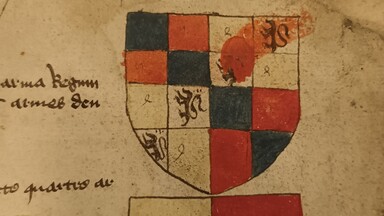
The Coat of Arms of Anne of Bohemia, Queen of England (d. 1394)
GO MS 7 provides a wonderful visual guide to the world of late medieval heraldry which has an arguably unfounded reputation for obscurity. The technical language utilised by late medieval heralds – once understood – is in fact straightforward. Consider the following image, labelled as the arms of ‘lord Mo[n]tegu’ (the ‘Montegu’ or Montagu family were the earls of Salisbury in the fourteenth and early fifteenth centuries). The blazon for this image treis fusiles de goule oue le champe argent which simply means three red fusils (or thin lozenges) with a silver field.
3) The Coat of Arms of Lord Montagu

The Coat of Arms of Lord Montagu
The manuscript has a clear emphasis on English coats of arms however it also records the coats of arms used by the contemporary monarchies of late medieval Europe such as those of the ‘Roman Emperors’, otherwise known in modern parlance as the Holy Roman Emperors. It’s blazon records that the Roman Emperors, since ancient times, have been bearing a flattened black split eagle on a gold field.
4) The Coat of Arms of the Holy Roman Emperors
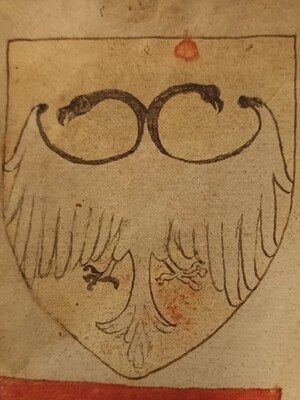
The Coat of Arms of the Holy Roman Emperors
As the double-headed eagle indicates, heraldry can contain images of many beasts and animals such as those found on the coat of arms described as being borne in the past by the kings of France which had three black botraces or bufones – venomous frogs or toads – on a silver field.
5) The Coat of Arms once borne by the Kings of France

The Coat of Arms once borne by the Kings of France
GO MS 7 is a fascinating manuscript that underscores the significance of NLI’s heraldic collections. reveals a colourful side to late medieval and early modern societies and shows the importance they placed on visual symbols. Heraldry is important for art history and – unsurprisingly – for family history. Once the barriers of technical language are overcome, heraldry offers a rewarding venture for historical research.
6) The Coat of Arms of Lord Stanley
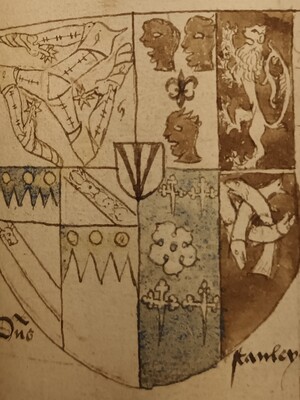
The Coat of Arms of Lord Stanley
